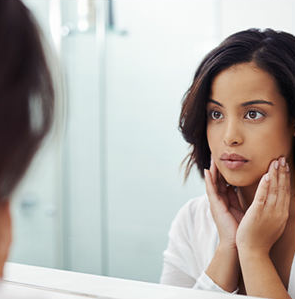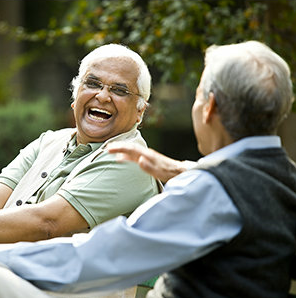Guide for a Healthier Self Image

With Zoom meetings, FaceTime dates, and social media time, it seems like we are more preoccupied than ever before on our own reflections.
The way you perceive yourself – especially your appearance – is referred to as your body image. And these perceptions are often not so positive. If you’ve ever judged a part of your body, wishing it were different, or had a negative thought about your appearance, you’re not alone. We have all done this from time to time. Because the way you perceive yourself can have significant affects on your overall wellbeing, we can all benefit from a body image tune-up.
Read on as Tara Rybicki, MS, RD, CDE, Munson Healthcare Community Health Coordinator, shares steps we can take today to attain a healthier body image.
Assess your current body image
“To me, body image is your interior perception of yourself through your mind’s eye,” Rybicki said. “There are many factors that feed our own perception of ourselves, such as comparing ourselves to others as well as how we think others perceive us.”

A good place to start evaluating your own personal body image is to think about the way you talk to yourself. When you think about yourself, pay specific attention to the following:
- Are you focusing on things you feel are flawed?
- Are you taking time to notice things you like about yourself beyond appearance?
- How do you treat yourself when you make a mistake?
The way we speak to ourselves is often much harsher than we would speak to a friend. This negative inner voice can wreak havoc in every area of our lives and drive us to make unhealthy decisions – like turning down a great opportunity or staying in a bad relationship. That’s why it’s so important to practice caring for yourself the same way you would a loved one.
Rybicki recommends that we evaluate our points of reference when we consider the way we see ourselves.
“Ask yourself, 'is my social media full of fitness influencers, diets, and young models?', 'Are my feeds only showing one body type or age group?' If you can evaluate the content you’re consuming and substitute influencers for those who value wellness over weight loss and happiness over air-brushed perfection, it can make a huge difference.”
Practice understanding your worth
It’s normal to have a few concerns about what you see in the mirror. The problem is when these concerns become obsessive thoughts and behaviors surrounding your physical appearance. Often, this focus ends up being on weight and body shape, the thickness and color of our hair, and our skin elasticity and the appearance of wrinkles, to name a few.
However, your true worth is not determined by any of these things. Rybicki encourages everyone to practice viewing themselves as worthy of love, kindness, and affection. Being unhappy with something about yourself does not take away from your worth as a human being.
“The truth is that no matter what we accomplish, what others think of us, or what we look like next to others, our value doesn’t change,” Rybicki said.
How can I improve the way I see myself?
Practice treating yourself well

You may catch yourself thinking thoughts like if I lost weight, had fewer wrinkles, or could only work harder, then I would like myself more – and so would others. Thoughts like these play into a very common, but untrue, perception of ourselves. Pay attention to these thoughts when they occur, and practice changing the way you’re thinking of and speaking to yourself.
“You can treat yourself well simply because you deserve to be well,” Rybicki said. “Our self-love doesn’t have to be conditional on having a certain body type or achieving weight loss. It can and should be now in this very moment.”
Treating yourself well because you deserve to be well means making an effort to care for yourself, not because you’re trying to change yourself, but because you deserve to be well. For example, reframe the way you think about healthy eating. Focus on eating well to nourish your body and improve your overall health and well-being versus focusing solely on weight loss or optics. It’s a subtle change that can go a long way.
Appreciate what your body can do
Practice being grateful for all the things your body does for you. From mowing the lawn to tucking your kids in at night, our bodies take us a long way every single day.
Assess where you are placing your worth
Often, we measure our self-worth based on many external factors, such as appearance, career, money, and achievements. However, Rybicki encourages us to challenge these perceptions. This way of thinking takes practice.
Check-in with yourself

Taking a moment to pause and check-in with yourself can be really helpful when looking to improve your body image.
Ask yourself:
- How am I feeling right now?
- How do I feel about myself today?
You may also choose to adopt a mantra or short phrase to re-center you when you start to feel negative thoughts about yourself creep in. Rybicki encourages us to seek a mantra that resonates, offering the following example. “My value is internal, inherent, and not defined by anything externally sourced such as my appearance, comparison to others, or the opinion of others.”
Improving your body image takes continuous – even daily – practice. Carving some time for this into your daily routine can help encourage you to practice these skills.
Ask for help when you need it
If you are struggling with negative self-perceptions or find yourself having obsessive thoughts about your body image, including your weight, appearance, or anything else, consider reaching out to a trusted friend or professional for help.
Increase your resilience
Resilience is our ability to adapt well to difficulties. It’s an important skill to build on to help you cope with stress or life challenges. In turn, increasing your resilience can boost your confidence.
“Resilience is not something that a person either has or does not have,” Rybicki said. “It can be built within each of us through the way we think and through the actions we take.”
To learn how you can increase your resilience, click the button below to download our Resilience Toolkit to help you build a personalized stress reduction plan.